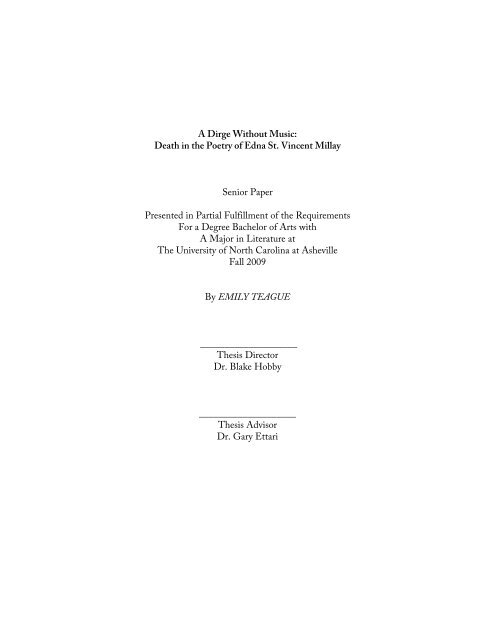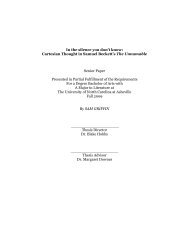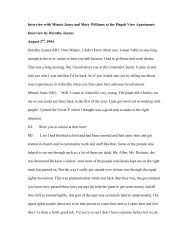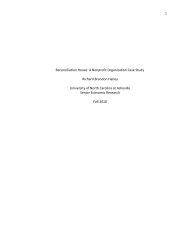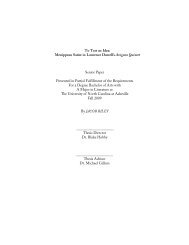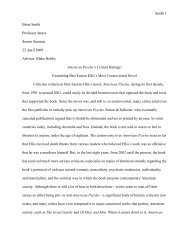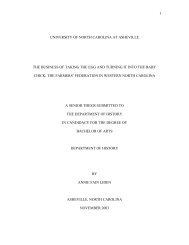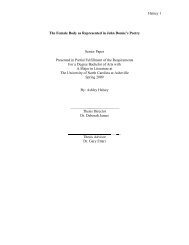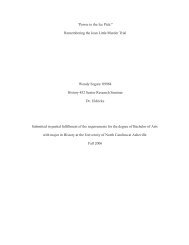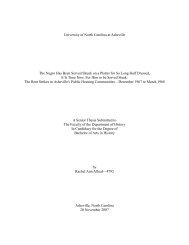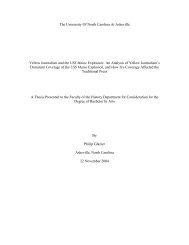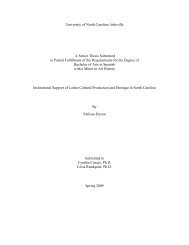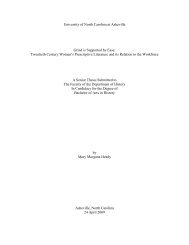A Dirge Without Music: Death in the Poetry of Edna St. Vincent Millay ...
A Dirge Without Music: Death in the Poetry of Edna St. Vincent Millay ...
A Dirge Without Music: Death in the Poetry of Edna St. Vincent Millay ...
You also want an ePaper? Increase the reach of your titles
YUMPU automatically turns print PDFs into web optimized ePapers that Google loves.
A <strong>Dirge</strong> <strong>Without</strong> <strong>Music</strong>:<strong>Death</strong> <strong>in</strong> <strong>the</strong> <strong>Poetry</strong> <strong>of</strong> <strong>Edna</strong> <strong>St</strong>. V<strong>in</strong>cent <strong>Millay</strong>Senior PaperPresented <strong>in</strong> Partial Fulfillment <strong>of</strong> <strong>the</strong> RequirementsFor a Degree Bachelor <strong>of</strong> Arts withA Major <strong>in</strong> Literature atThe University <strong>of</strong> North Carol<strong>in</strong>a at AshevilleFall 2009By EMILY TEAGUE____________________Thesis DirectorDr. Blake Hobby____________________Thesis AdvisorDr. Gary Ettari
Teague 2“<strong>Death</strong>” is perhaps <strong>the</strong> only word that can simultaneously strike strong emotions <strong>of</strong> fear, long<strong>in</strong>g,curiosity, sadness, and hope <strong>in</strong>to human hearts—even surpass<strong>in</strong>g love. And, along with love,death has become one <strong>of</strong> <strong>the</strong> predom<strong>in</strong>ant <strong>the</strong>mes <strong>of</strong> human endeavors. Scientists have studiednear-death experiences and attempted to determ<strong>in</strong>e <strong>the</strong> weight <strong>of</strong> <strong>the</strong> human soul, religiousleaders have tried to figure out how to cheat death through ga<strong>in</strong><strong>in</strong>g <strong>the</strong> best afterlife, and artistshave undertaken to effectively and beautifully express those complex emotions about death.<strong>Edna</strong> <strong>St</strong>. V<strong>in</strong>cent <strong>Millay</strong> was one such artist. Born <strong>in</strong> 1822 to an <strong>in</strong>dependent mo<strong>the</strong>rdevoted to provid<strong>in</strong>g artistic outlets for her daughters, <strong>Millay</strong> grew up steeped <strong>in</strong> both hardshipand poetic tradition. At a time when many poets abandoned traditional forms for modern freeverse, <strong>Millay</strong> became a master <strong>of</strong> sonnets and ballads. Deeply disturbed by <strong>the</strong> idea <strong>of</strong> death anddy<strong>in</strong>g, she used an emphasis on form and wordplay <strong>in</strong> her extremely biographical poems as amechanism for handl<strong>in</strong>g emotions she found too unsettl<strong>in</strong>g to confront directly. As AdrienneRich so eloquently expla<strong>in</strong>ed about her own work, “…formalism was part <strong>of</strong> <strong>the</strong> strategy—likeasbestos gloves, it allowed me to handle materials I couldn’t pick up barehanded” (Rich 22).Us<strong>in</strong>g formal diction and structure, ligh<strong>the</strong>arted rhythms and rhymes, or poetic tradition mixedwith what could be called ei<strong>the</strong>r denial or pr<strong>of</strong>essional optimism, <strong>Edna</strong> <strong>St</strong>. V<strong>in</strong>cent <strong>Millay</strong>created <strong>in</strong> her poetry a safe space to explore thoughts and emotions about death. In thisexploration, she <strong>of</strong>ten divided death <strong>in</strong>to three manageable spheres—her own triumphant death,<strong>the</strong> sad but survivable death <strong>of</strong> love, or <strong>the</strong> bitter death <strong>of</strong> a loved one.In recent years, <strong>the</strong> critical response to <strong>Millay</strong>’s poetry has become <strong>in</strong>creas<strong>in</strong>gly genderbased.In “<strong>Edna</strong> <strong>St</strong>. V<strong>in</strong>cent <strong>Millay</strong> and <strong>the</strong> Language <strong>of</strong> Vulnerability,” Jane <strong>St</strong>anbrough arguesthat <strong>Millay</strong>’s famous “flippancy” and formalism work to hide <strong>the</strong> essential pa<strong>in</strong> and vulnerability
Teague 3she feels as a woman. She works through selected poems from across <strong>Millay</strong>’s career, from <strong>the</strong>second collection A Few Figs from Thistles to <strong>the</strong> posthumous M<strong>in</strong>e <strong>the</strong> Harvest. In Figs sheexpla<strong>in</strong>s <strong>the</strong> vulnerable, disappo<strong>in</strong>ted child hidden beneath <strong>the</strong> lilt<strong>in</strong>g verses <strong>of</strong> “Grown-up,” asimple and ligh<strong>the</strong>arted poem about <strong>the</strong> unexpected boredom <strong>of</strong> adult life. <strong>St</strong>anbrough showshow this ligh<strong>the</strong>artedness hides a darker mean<strong>in</strong>g: “grow<strong>in</strong>g <strong>in</strong>to adult domesticity for thiswoman has been a process <strong>of</strong> subdu<strong>in</strong>g <strong>the</strong> will and shr<strong>in</strong>k<strong>in</strong>g <strong>the</strong> soul…“domestic as a plate” isan image that fits woman <strong>in</strong>to her conventional place at rest on a shelf and out <strong>of</strong> <strong>the</strong> way”(<strong>St</strong>anbrough 214). Mov<strong>in</strong>g on from Figs, <strong>St</strong>anbrough addresses <strong>the</strong> sonnet sequence FatalInterview, a series <strong>of</strong> poems about <strong>the</strong> lifespan <strong>of</strong> a torrid love affair. “Throughout <strong>the</strong> sonnets,<strong>the</strong> narrator exposes her emotional vulnerability to assault, humiliation, abuse, abandonment,annihilation” (<strong>St</strong>anbrough 226). <strong>St</strong>anbrough consistently likens <strong>the</strong> affair to sexual abuse that <strong>the</strong>speaker is <strong>in</strong>capable <strong>of</strong> escap<strong>in</strong>g on her own, and <strong>the</strong> sonnet form itself as a symbol <strong>of</strong> herconstra<strong>in</strong>t.The sonnet, her best form, is a fit vehicle to convey her deepest feel<strong>in</strong>gs <strong>of</strong>woman’s victimization. Through it, <strong>Millay</strong> imag<strong>in</strong>atively reenacts her constantstruggle aga<strong>in</strong>st boundaries. The wish for freedom is always qualified by <strong>the</strong> sense<strong>of</strong> restriction; couplets and quatra<strong>in</strong>s suit her sensibilities. (<strong>St</strong>anbrough 227)This balance between restriction and freedom, accord<strong>in</strong>g to <strong>St</strong>anbrough, is a uniquely fem<strong>in</strong><strong>in</strong>eapproach to poetry; <strong>Millay</strong>’s use <strong>of</strong> <strong>the</strong> male form <strong>of</strong> <strong>the</strong> sonnet is a surrender to and expression<strong>of</strong> helplessness under male-dom<strong>in</strong>ated society.On <strong>the</strong> o<strong>the</strong>r side <strong>of</strong> <strong>the</strong> same gendered co<strong>in</strong>, Debra Fried argues aga<strong>in</strong>st <strong>St</strong>anbrough’sposition <strong>in</strong> “Andromeda Unbound: Gender and Genre <strong>in</strong> <strong>Millay</strong>'s Sonnets.” Fried claims that<strong>Millay</strong> does not choose her formal style to hide or to reenact her fem<strong>in</strong><strong>in</strong>e vulnerabilities, but to
Teague 4subvert such traditionally mascul<strong>in</strong>e forms as <strong>the</strong> sonnet for her own purposes. Ra<strong>the</strong>r thanask<strong>in</strong>g why <strong>Millay</strong>, as a modern woman, chose to use <strong>the</strong> traditional and mascul<strong>in</strong>e form <strong>of</strong> <strong>the</strong>sonnet, Fried claims that critics “have tended to assume that we know just how and why a poetlike <strong>Millay</strong> must use circumscribed, traditional poetic forms: to re<strong>in</strong> <strong>in</strong> her strong, unrulyfeel<strong>in</strong>gs” (Fried 229). She takes issue with <strong>St</strong>anbrough’s assertion that such re<strong>in</strong><strong>in</strong>g <strong>in</strong> is afem<strong>in</strong><strong>in</strong>e approach to poetry: “what poetic ‘sensibility,’ we may ask, is not <strong>in</strong> some degree suitedto <strong>the</strong> strictures <strong>of</strong> poetic form?” (Fried 230). Fried constructs <strong>Millay</strong>’s use <strong>of</strong> sonnet, ra<strong>the</strong>r, as aclaim<strong>in</strong>g <strong>of</strong> a form traditionally denied to women; <strong>in</strong> an analysis <strong>of</strong> Wordsworth’s “Nuns FretNot At Their Convent’s Narrow Room,” she f<strong>in</strong>ds that <strong>the</strong> mascul<strong>in</strong>e Romantic view <strong>of</strong> <strong>the</strong>sonnet is one <strong>of</strong> escape from “<strong>the</strong> weight <strong>of</strong> too much liberty” <strong>in</strong> life and <strong>in</strong> creative expression.This escape is not one shared by women, who “conf<strong>in</strong>ed by <strong>the</strong>ir sex <strong>in</strong> a scanty plot…cannotenjoy quite this brand <strong>of</strong> Wordsworthian solace <strong>in</strong> putt<strong>in</strong>g on <strong>the</strong> corset <strong>of</strong> strict lyric form.” Theexcess <strong>of</strong> liberty is <strong>the</strong> liberty to write great epic works; a liberty <strong>the</strong> female poet is denied. “Thewoman may be his [<strong>the</strong> bard’s] muse, but she can never follow him up <strong>the</strong> graded ladder <strong>of</strong>poetic modes” (Fried 233-234). Fried <strong>the</strong>n connects poetic freedom with sexual freedom,ano<strong>the</strong>r liberty traditionally afforded to men but denied to women, and compares <strong>the</strong> sonnet to<strong>Millay</strong>’s famous assertion that “[her] candle burns at both ends.” The sonnet uses itself up, neatlybut forcibly spend<strong>in</strong>g all its energies—us<strong>in</strong>g its limited space to <strong>the</strong> fullest, with noth<strong>in</strong>g wasted.The sonnet form, <strong>the</strong>n, mimics <strong>Millay</strong>’s identity as a “New Woman,” free to live so that all herpassions are used to <strong>the</strong> fullest (Fried 235-236)However, <strong>the</strong>se and o<strong>the</strong>r gender-based views are, while reasonable, not <strong>the</strong> bestapproach to <strong>Millay</strong>’s work; she was, after all, a person with more <strong>in</strong>fluences on her work thanmerely her gender, and her struggle with death is one <strong>of</strong> <strong>the</strong> largest <strong>of</strong> those <strong>in</strong>fluences. As J.D.
Teague 5McClatchy states, “The eng<strong>in</strong>e that drove her poetry--as it may have propelled her life, throughlove affairs and addictions--was death. Her fear <strong>of</strong> it haunted her desperate apostrophes to <strong>the</strong>romantic moment, and chilled her appraisals <strong>of</strong> loss” (McClatchy). From a very early age,V<strong>in</strong>cent (as she was known to close friends and family) was troubled by death. As an adult, sheremembered <strong>the</strong> moment when, as a small child, she first realized that death could claimsomeone she loved:“I laid my cheek s<strong>of</strong>tly down upon <strong>the</strong> cool [piano] keys and wept. For it hadcome <strong>in</strong>to my m<strong>in</strong>d with dreadful violence as she bent above me and placed herf<strong>in</strong>gers upon <strong>the</strong> keys…that my mo<strong>the</strong>r could die; and I wanted to save her fromthat, for I knew she would not like it; and I knew that I could not” (Milford 25).This early revelation, that death could and would take away her loved ones, rema<strong>in</strong>ed <strong>the</strong> subject<strong>of</strong> <strong>the</strong> bitterest <strong>of</strong> <strong>Millay</strong>’s poems on death. Her approach to her own death, however, appearsconsistently disbeliev<strong>in</strong>g, as if she was constantly search<strong>in</strong>g for a way around her own mortality,whe<strong>the</strong>r through literary immortality or some more miraculous occurrence.One <strong>of</strong> <strong>Millay</strong>’s first and best-known poems, “Renascence,” is also one <strong>of</strong> <strong>the</strong> first toexplore her feel<strong>in</strong>gs on her own death. Probably begun <strong>in</strong> 1911 and f<strong>in</strong>ished <strong>in</strong> 1912, at a timewhen <strong>Millay</strong> had f<strong>in</strong>ished high school and had not found a job or a way to attend college, itaddressed her feel<strong>in</strong>gs <strong>of</strong> be<strong>in</strong>g bound and smo<strong>the</strong>red to death <strong>in</strong> her small Ma<strong>in</strong>e town <strong>in</strong> <strong>the</strong>form <strong>of</strong> a children’s simple count<strong>in</strong>g rhyme. Gorham Munson believes that she scene she setshere is <strong>the</strong> scenery <strong>of</strong> Mount Battie and Penobscot Bay (Munson 266).All I could see from where I stoodWas three long mounta<strong>in</strong>s and a wood.I turned and looked ano<strong>the</strong>r way
Teague 6And saw three islands <strong>in</strong> a bay.…Over <strong>the</strong>se th<strong>in</strong>gs I could not seeThese were <strong>the</strong> th<strong>in</strong>gs that bounded me.The problem <strong>of</strong> her conf<strong>in</strong>ement is <strong>in</strong>troduced <strong>in</strong> a simple, rigid form—rhymed couplets<strong>in</strong> iambic pentameter, a form she rarely breaks <strong>in</strong> all 214 l<strong>in</strong>es. In <strong>the</strong> course <strong>of</strong> <strong>the</strong> poem,<strong>Millay</strong>’s speaker—a stand-<strong>in</strong> for <strong>Millay</strong> herself—is suffocated by <strong>the</strong> smallness <strong>of</strong> her immediatesurround<strong>in</strong>gs and <strong>the</strong> <strong>in</strong>f<strong>in</strong>ite size and <strong>of</strong> <strong>the</strong> universe outside—“Immensity made manifold”—and <strong>the</strong> relentless death and pa<strong>in</strong> suffered by all <strong>of</strong> humanity. “…Hurt and pa<strong>in</strong> createcompassion, but <strong>in</strong> fact it is <strong>the</strong> blended elements <strong>of</strong> godhead, omnisentience plus love, justice,and pity…that prove too much for <strong>the</strong> ‘f<strong>in</strong>ite Me’” (Britt<strong>in</strong> 30). The torture cont<strong>in</strong>ues until shef<strong>in</strong>ds no escape but death:Into <strong>the</strong> earth I sank till IFull six feet under ground did lie,And sank no more—<strong>the</strong>re is no weightCan follow here, however great.She chooses her own death. Munson’s hik<strong>in</strong>g companions wonder at <strong>the</strong> suffocation(“you just can’t feel claustrophobic on this mounta<strong>in</strong> top,” says <strong>the</strong> poet) and <strong>the</strong> physicalpossibility <strong>of</strong> <strong>the</strong> s<strong>in</strong>k<strong>in</strong>g (“<strong>the</strong> sp<strong>in</strong>e <strong>of</strong> this mounta<strong>in</strong> is an exceptionally hard rock…I can’t givelicense to a poet to s<strong>in</strong>k through rock as hard as this” declares <strong>the</strong> scientist). The impossibilitiesimplied by her landscape speak to <strong>the</strong> unbearableness <strong>of</strong> <strong>Millay</strong>/speaker’s situation, be<strong>in</strong>g bothbound by New England life but all too free <strong>in</strong> her <strong>in</strong>f<strong>in</strong>ite compassion. The death she f<strong>in</strong>dspleasant as a cessation <strong>of</strong> pa<strong>in</strong> does not, however, satisfy her for long: upon miss<strong>in</strong>g <strong>the</strong> beauty <strong>of</strong>
Teague 7<strong>the</strong> natural world over her grave, breaks out <strong>of</strong> <strong>the</strong> earth <strong>in</strong> a cathartic rush <strong>of</strong> ra<strong>in</strong>. She escapesher own death, even escap<strong>in</strong>g <strong>the</strong> idea <strong>of</strong> death <strong>in</strong> <strong>the</strong> last stanza, <strong>in</strong> which she asserts <strong>the</strong>supernatural power <strong>of</strong> <strong>the</strong> soul and <strong>the</strong> heart.The world stands out on ei<strong>the</strong>r sideNo wider than <strong>the</strong> heart is wide;Above <strong>the</strong> world is stretched <strong>the</strong> sky,—No higher than <strong>the</strong> soul is high.The autobiographical nature <strong>of</strong> <strong>Millay</strong>’s work is clear <strong>in</strong> “Renascence,” and cannot beignored <strong>in</strong> <strong>the</strong> rest <strong>of</strong> her work. “The self <strong>in</strong> her work,” Suzanne Clark expla<strong>in</strong>s, “is an actressperform<strong>in</strong>g, at once embodiment and <strong>in</strong>terpretation. There is no separation <strong>of</strong> artist and person”(Clark 5).“Renascence” was <strong>the</strong> first poem to catapult <strong>Millay</strong> to stardom, w<strong>in</strong>n<strong>in</strong>g fourth place <strong>in</strong><strong>the</strong> anthology The Lyric Year <strong>in</strong> 1912. That year, she also attracted <strong>the</strong> attention <strong>of</strong> Carol<strong>in</strong>e B.Dow, who helped raise money for her to go to school at Vassar College. <strong>Millay</strong>’s life at Vassarwas full <strong>of</strong> ups and downs, as her <strong>in</strong>solence and flirtatiousness alternately made friends andenemies with <strong>the</strong> rest <strong>of</strong> <strong>the</strong> student body, most <strong>of</strong> whom were four years her juniors. Aftergraduation, her first collection, Renascence and O<strong>the</strong>r Poems, was published, followed by <strong>the</strong> bookthat truly secured her fame: A Few Figs from Thistles. Figs was composed <strong>of</strong> light verse, full <strong>of</strong>flippant fun and sexual freedom, culled from ano<strong>the</strong>r more serious collection to come later—Second April.<strong>Millay</strong>’s publisher shied away from publish<strong>in</strong>g Second April because <strong>of</strong> <strong>the</strong> heavy <strong>the</strong>me <strong>of</strong>death present throughout <strong>the</strong> poems. In 1918, one <strong>of</strong> <strong>Millay</strong>’s Vassar classmates (and possiblelovers) Dorothy Coleman, had died suddenly and tragically <strong>in</strong> <strong>the</strong> flu epidemic. Whatever
Teague 8<strong>Millay</strong>’s feel<strong>in</strong>gs had been for <strong>the</strong> girl, Coleman was among her admirers and her diaries“revealed a secret and tumultuous passion” for <strong>Millay</strong> (Epste<strong>in</strong> 96). The death <strong>of</strong> such a devotedfollower spurred <strong>Millay</strong> to write more eloquently than ever on this most dark and <strong>in</strong>terest<strong>in</strong>g <strong>of</strong><strong>the</strong>mes. Macmillan specifically asked for “Memorial to D.C.,” five poems written for Coleman,to be cut from <strong>the</strong> book, but <strong>Millay</strong> refused. “<strong>Death</strong> moved through <strong>the</strong>se poems like a morbidfever,” and <strong>the</strong> publishers reacted with a horror foreign to <strong>the</strong> Roman and Elizabethan poets <strong>in</strong>whom <strong>Millay</strong> had found <strong>in</strong>spiration (Milford 188-189). “Memorial to D.C.” is far from <strong>the</strong> onlypoem <strong>in</strong> Second April to take hold <strong>of</strong> death with its asbestos gloves—<strong>the</strong> very first poem,“Spr<strong>in</strong>g,” beg<strong>in</strong>s <strong>the</strong> book with <strong>the</strong> topic <strong>of</strong> death, set <strong>in</strong> <strong>the</strong> season <strong>of</strong> rebirth. This poem belongs<strong>in</strong> <strong>the</strong> bitterest <strong>of</strong> <strong>Millay</strong>’s three categories: death <strong>of</strong> <strong>the</strong> beloved. Clark expla<strong>in</strong>s, “death and griefis a frequent subject <strong>in</strong> <strong>Millay</strong>’s poems. But it is her own death she fears?...death is associated <strong>in</strong>her text with <strong>the</strong> pa<strong>in</strong> <strong>of</strong> los<strong>in</strong>g someone else” (Clark 9-10).“Spr<strong>in</strong>g” marks a new turn <strong>in</strong> <strong>Millay</strong>’s poetry: “[<strong>the</strong> poem] conta<strong>in</strong>s no unnecessary words,presents its images directly and visually, and is written <strong>in</strong> free verse” (Kaiser 30). The poem’seighteen l<strong>in</strong>es dim<strong>in</strong>ish on <strong>the</strong> page until <strong>the</strong> seventeenth l<strong>in</strong>e is only one word long, echo<strong>in</strong>g <strong>the</strong>deepen<strong>in</strong>g despair <strong>of</strong> <strong>the</strong> poem as <strong>Millay</strong>’s speaker retreats ever fur<strong>the</strong>r away from <strong>the</strong> outsideworld. <strong>Millay</strong> beg<strong>in</strong>s by directly address<strong>in</strong>g <strong>the</strong> month: “To what purpose, April, do you returnaga<strong>in</strong>?” (“Spr<strong>in</strong>g” l<strong>in</strong>e 1) The classic apostrophe to spr<strong>in</strong>g and <strong>the</strong> formality <strong>of</strong> <strong>the</strong> question, serveto contrast and temper its rudeness, as <strong>the</strong> question is essentially “what <strong>the</strong> hell are you do<strong>in</strong>ghere?” This first l<strong>in</strong>e alerts us that someth<strong>in</strong>g is not right <strong>in</strong> <strong>Millay</strong>’s world—<strong>of</strong> course Aprilshould come aga<strong>in</strong>. Why would she not want it to?The next statement is even blunter: “Beauty is not enough” (2). “The poem’s aes<strong>the</strong>ticrefusal to admit any <strong>of</strong> <strong>the</strong> more traditional poetic embellishments is echoed and re<strong>in</strong>forced” by
Teague 9this l<strong>in</strong>e; “…no beauty, whe<strong>the</strong>r it results from <strong>the</strong> nature <strong>of</strong> spr<strong>in</strong>g itself or from <strong>the</strong> formalaes<strong>the</strong>tics <strong>of</strong> poetry,” can ease whatever pa<strong>in</strong> she is <strong>in</strong> (Kaiser 30). She cont<strong>in</strong>ues to berate <strong>the</strong>spr<strong>in</strong>g month, declar<strong>in</strong>g that it cannot “quiet” her anymore. The word “quiet” here suggests animage <strong>of</strong> a parent mollify<strong>in</strong>g a child with a distraction ra<strong>the</strong>r than direct comfort, but April is notbrib<strong>in</strong>g <strong>Millay</strong> with candy, but with “<strong>the</strong> redness <strong>of</strong> little leaves open<strong>in</strong>g stickily” (3-4). Thewords “little” and “stickily” seem <strong>in</strong>nocent and childlike <strong>in</strong> <strong>the</strong>ir simplicity, and <strong>the</strong> sticky leavesare rem<strong>in</strong>iscent <strong>of</strong> sticky candies, or <strong>the</strong> small sticky hands <strong>of</strong> young children.This beautiful l<strong>in</strong>e is a momentary distraction, like sticky candies, from <strong>the</strong> ris<strong>in</strong>g despair,until <strong>Millay</strong> abruptly cont<strong>in</strong>ues with “I know what I know.” (5) She does not reveal what it is sheknows for <strong>the</strong> next few l<strong>in</strong>es, as she aga<strong>in</strong> describes <strong>the</strong> spr<strong>in</strong>g growth, this time without <strong>the</strong>pleasure <strong>of</strong> <strong>the</strong> red leaf image: “<strong>the</strong> sun is hot” and <strong>the</strong> crocuses are “spikes,” as she coldly“observes” <strong>the</strong>m, with none <strong>of</strong> <strong>the</strong> rapturous attention she gave <strong>the</strong> little leaves (6-7). She statesthat <strong>the</strong> earth smells “good,” without detail<strong>in</strong>g how (8). Then, coldly and ironically, she says “it isapparent that <strong>the</strong>re is no death.” (9) The word “apparent” br<strong>in</strong>gs up <strong>the</strong> old say<strong>in</strong>g aboutappearances be<strong>in</strong>g deceiv<strong>in</strong>g, which she supports by ask<strong>in</strong>g, sarcastically, what this appearancesignifies (10). The first l<strong>in</strong>e may have been blunt, but through <strong>the</strong>se l<strong>in</strong>es <strong>the</strong> poem descends <strong>in</strong>togreater bitterness about <strong>the</strong> knowledge <strong>of</strong> death, and <strong>the</strong>nce <strong>in</strong>to bitterness about life. “Life <strong>in</strong>itself/ Is noth<strong>in</strong>g,” <strong>Millay</strong> declares, <strong>the</strong>n diverts this raw outcry <strong>in</strong>to metaphor: “An empty cup, aflight <strong>of</strong> uncarpeted stairs” (13-15). “It is not enough” that April, like <strong>the</strong> doomed Ophelia,“Comes like an idiot, babbl<strong>in</strong>g and strew<strong>in</strong>g flowers” (17-18).The mere knowledge <strong>of</strong> mortality is crush<strong>in</strong>gly depress<strong>in</strong>g to <strong>Millay</strong> <strong>in</strong> “Spr<strong>in</strong>g,” so muchso that even <strong>the</strong> rebirth <strong>of</strong> <strong>the</strong> entire hemisphere cannot comfort her, but she consistently forcesthis emotion <strong>in</strong>to poetic forms that take a step back from raw bitterness. She couches her rude
Teague 13up <strong>in</strong> spr<strong>in</strong>g (49-56). Her physical death contrasts with <strong>the</strong>se images <strong>of</strong> new growth, and with<strong>the</strong> sexual imagery <strong>of</strong> <strong>the</strong> next stanza, where she resumes begg<strong>in</strong>g “boys and girls that lie/whisper<strong>in</strong>g <strong>in</strong> <strong>the</strong> hedges” (57-58). The proximity <strong>of</strong> <strong>the</strong>se images implies that just as her bodycontributes to <strong>the</strong> fertility <strong>of</strong> <strong>the</strong> land, her poems, mixed with <strong>the</strong> pledges <strong>of</strong> <strong>the</strong>se lovers,contribute to <strong>the</strong> fertility <strong>of</strong> <strong>the</strong> human race. The manner <strong>in</strong> which she implores such readers tomix her <strong>in</strong> with <strong>the</strong>ir day to day lives also suggests a desire to go on liv<strong>in</strong>g <strong>in</strong> a mundane, physicalsense after death, even if only vicariously.The f<strong>in</strong>al stanza <strong>of</strong> “The Poet and His Book” assumes <strong>the</strong> success <strong>of</strong> her pleas, as shetaunts a sexton for <strong>the</strong> impermanence <strong>of</strong> his trade compared to hers—“Many a rose shall ravel,/Many a metal wreath shall rust” while her songs abide (116-117). The proliferation <strong>of</strong>exclamation po<strong>in</strong>ts through this stanza <strong>in</strong> particular, as well as <strong>the</strong> poem throughout, suggests<strong>Millay</strong>’s enthusiastic determ<strong>in</strong>ation to make her aim <strong>of</strong> poetic immortality come true. Thisdeterm<strong>in</strong>ation is itself a protection aga<strong>in</strong>st <strong>the</strong> fear and dread associated with <strong>the</strong> anticipation <strong>of</strong>one’s own mortality. She fervently wishes to believe her own assertion that “…Only <strong>the</strong> body canbe brought to earth; but <strong>the</strong> spirit, <strong>the</strong> essential ‘I,’ will survive” (Britt<strong>in</strong> 45). Though desperate,<strong>Millay</strong> protects and distances herself from this particular anxiety, not completely through tricks<strong>of</strong> language or tone, but through determ<strong>in</strong><strong>in</strong>g to never die.Between Second April <strong>in</strong> 1921 and The Buck <strong>in</strong> <strong>the</strong> Snow <strong>in</strong> 1928, <strong>Millay</strong> spent time <strong>in</strong>Europe, published The Harp-Weaver and O<strong>the</strong>r Poems, became <strong>the</strong> first woman to w<strong>in</strong> <strong>the</strong>Pulitzer Prize, married Eugen Jan Boisseva<strong>in</strong>, and experienced <strong>the</strong> beg<strong>in</strong>n<strong>in</strong>g <strong>of</strong> her slide <strong>in</strong>tobad health. <strong>Millay</strong> and Boisseva<strong>in</strong> fell <strong>in</strong> love over a game <strong>of</strong> charades <strong>in</strong> April 1923, and weremarried <strong>in</strong> July. <strong>Millay</strong> had been ill s<strong>in</strong>ce before her return from Europe <strong>in</strong> January, and directlyafter <strong>the</strong> wedd<strong>in</strong>g Boisseva<strong>in</strong> drove her to New York Hospital to have a complicated <strong>in</strong>test<strong>in</strong>al
Teague 14problem fixed and her appendix removed. Marriage was <strong>the</strong> only way <strong>the</strong>y could be sure to betoge<strong>the</strong>r while she was <strong>in</strong>capacitated. This almost mo<strong>the</strong>rly care from her husband was to berepresentative <strong>of</strong> <strong>the</strong> rest <strong>of</strong> <strong>the</strong>ir life toge<strong>the</strong>r. Boisseva<strong>in</strong> managed <strong>the</strong>ir household, leav<strong>in</strong>g<strong>Millay</strong> to her poetry, because as he said “it is so obvious that V<strong>in</strong>cent is more important than Iam” (Britt<strong>in</strong> 23). Just before <strong>the</strong> appendectomy, she said to her good friend Arthur Ficke “If I dienow, I shall be immortal” (Milford 254-255).She survived <strong>the</strong> surgery, but <strong>Millay</strong>’s awareness <strong>of</strong> her own mortality grows more evident<strong>in</strong> The Buck <strong>in</strong> <strong>the</strong> Snow; as Untermeyer put it, “never has Miss <strong>Millay</strong> plucked so <strong>in</strong>sistently on<strong>the</strong> autumnal str<strong>in</strong>g” (“Song” 57). The image <strong>of</strong> triumphal self-death most common <strong>in</strong> her earlierwork is replaced by a more thoughtful approach, occasionally reach<strong>in</strong>g an objectivity also rare <strong>in</strong>her deeply personal and emotional work. This thoughtfulness, or “presence <strong>of</strong> m<strong>in</strong>d,” caused atleast one reviewer to declare The Buck <strong>in</strong> <strong>the</strong> Snow “<strong>the</strong> emergence <strong>of</strong> a significant poet” (Parks121). In <strong>the</strong> title poem, <strong>Millay</strong> approaches death with less formal protection; her l<strong>in</strong>es are longerand looser, “no longer conf<strong>in</strong>ed to tight couplets or casual quatra<strong>in</strong>s” (“Song” 58). But at <strong>the</strong>same time she ma<strong>in</strong>ta<strong>in</strong>s distance from her subject, even a greater distance than <strong>in</strong> o<strong>the</strong>r, moreformal poems: it is not she or a loved one, or even ano<strong>the</strong>r human be<strong>in</strong>g, who is dy<strong>in</strong>g; herspeaker/self watches from a distance as a buck deer dies. This twelve l<strong>in</strong>e poem, arranged <strong>in</strong> threeuneven stanzas <strong>of</strong> five, one, and six l<strong>in</strong>es, is marked by a sense <strong>of</strong> reflection, reserve, and wonder.She beg<strong>in</strong>s by address<strong>in</strong>g <strong>the</strong> “white sky, over <strong>the</strong> hemlocks bowed with snow,” elegantlysett<strong>in</strong>g <strong>the</strong> scene <strong>in</strong> shades <strong>of</strong> black and white. She cont<strong>in</strong>ues with a question for <strong>the</strong> sky, “sawyou not,” a formal <strong>in</strong>version characteristic <strong>of</strong> <strong>Millay</strong>’s deliberately poetic, distanc<strong>in</strong>g diction, andalso a quiet demand for <strong>the</strong> acknowledgement <strong>of</strong> death <strong>of</strong> <strong>the</strong> “antlered buck.” “I saw <strong>the</strong>m,” shesays, <strong>the</strong>n repeats “I saw <strong>the</strong>m suddenly go,” assert<strong>in</strong>g her own knowledge. This is a l<strong>in</strong>k back to
Teague 15<strong>the</strong> all-compassionate <strong>Millay</strong> <strong>of</strong> “Renascence,” who knows and feels for all <strong>the</strong> world’ssuffer<strong>in</strong>g—but now, <strong>Millay</strong> demands that <strong>the</strong> rest <strong>of</strong> <strong>the</strong> universe also feel her suffer<strong>in</strong>g andbewilderment over death. The abrupt beg<strong>in</strong>n<strong>in</strong>g <strong>of</strong> <strong>the</strong> next l<strong>in</strong>e, “tails up,” mimics <strong>the</strong> suddenalertness <strong>of</strong> <strong>the</strong> startled deer, while <strong>the</strong> alliteration <strong>of</strong> “long leaps lovely and slow” imitates <strong>the</strong>motion <strong>of</strong> <strong>the</strong> runn<strong>in</strong>g deer. <strong>Millay</strong> sets <strong>the</strong> next l<strong>in</strong>e apart from <strong>the</strong> two long stanzas, mak<strong>in</strong>g itstand out sharply: “now lies he here, his wild blood scald<strong>in</strong>g <strong>the</strong> snow.” Ano<strong>the</strong>r poetic <strong>in</strong>versionhere also slows <strong>the</strong> pace <strong>of</strong> <strong>the</strong> poem with four stressed syllables <strong>in</strong> a row, prepar<strong>in</strong>g for <strong>the</strong>shock<strong>in</strong>g image <strong>of</strong> <strong>the</strong> deer’s blood aga<strong>in</strong>st <strong>the</strong> white snow. The <strong>in</strong>terruption <strong>of</strong> <strong>the</strong> s<strong>in</strong>gle l<strong>in</strong>e<strong>of</strong>fset from <strong>the</strong> two stanzas also mimics <strong>the</strong> <strong>in</strong>terruption <strong>of</strong> death onto <strong>the</strong> peaceful scene <strong>of</strong> <strong>the</strong>two deer leap<strong>in</strong>g through <strong>the</strong> orchard, a death likely caused by a human hunter—an <strong>in</strong>vader,<strong>in</strong>terrupt<strong>in</strong>g and end<strong>in</strong>g <strong>the</strong> quiet, beautiful, and natural life <strong>of</strong> <strong>the</strong> deer which <strong>Millay</strong> set up <strong>in</strong><strong>the</strong> first stanza. With such a set-up, this sudden death seems all <strong>the</strong> more unjust.Despite <strong>the</strong> shock <strong>of</strong> <strong>the</strong> hunter’s <strong>in</strong>trusion, <strong>the</strong> narrator/<strong>Millay</strong> herself could also be seenas a human trespasser, impos<strong>in</strong>g her thoughts and feel<strong>in</strong>gs onto <strong>the</strong> deer and its death. In <strong>the</strong>very next l<strong>in</strong>e, <strong>Millay</strong> departs from pure description to say “how strange a th<strong>in</strong>g is death” withdistant wonder, as if at a phenomenon that would never affect her. Consider<strong>in</strong>g <strong>the</strong> ever morepress<strong>in</strong>g concerns <strong>of</strong> <strong>Millay</strong>’s own mortality, this cool assessment is both remarkable and, yet,somehow unsurpris<strong>in</strong>g: we could expect a note <strong>of</strong> hysteria and fear to sound loudly <strong>in</strong> this poem,but it’s also sensible to expect a calmer approach towards someth<strong>in</strong>g she surely felt was draw<strong>in</strong>gnigh. The strangeness she draws attention to lies <strong>in</strong> <strong>the</strong> fall <strong>of</strong> <strong>the</strong> swift and beautiful deer—death “br<strong>in</strong>g<strong>in</strong>g to his knees, br<strong>in</strong>g<strong>in</strong>g to his antlers/ The buck <strong>in</strong> <strong>the</strong> snow.” The mention <strong>of</strong> hisblood as “wild” <strong>in</strong> l<strong>in</strong>e seven, added to this description <strong>of</strong> <strong>the</strong> “strangeness” <strong>of</strong> death as <strong>the</strong>cessation <strong>of</strong> movement provides an idea <strong>of</strong> death tam<strong>in</strong>g <strong>the</strong> once-free buck. She <strong>the</strong>n ponders
Teague 16<strong>the</strong> strangeness <strong>of</strong> life, “a mile away by now…look<strong>in</strong>g out attentive from <strong>the</strong> eyes <strong>of</strong> <strong>the</strong> doe.” Itis strange that <strong>the</strong> buck has been tamed and stilled by death, but it is also strange that life, <strong>in</strong> <strong>the</strong>form <strong>of</strong> <strong>the</strong> buck’s mate, goes on after <strong>the</strong> death <strong>of</strong> her loved one. But <strong>the</strong> life itself is not harmedby <strong>the</strong> buck’s untimely end; it merely runs to save itself, keep<strong>in</strong>g an “attentive” eye out for <strong>the</strong>threat <strong>of</strong> its own death. The doe is pure natural <strong>in</strong>st<strong>in</strong>ct, and <strong>in</strong> <strong>the</strong> wonder <strong>Millay</strong> feels towardits cont<strong>in</strong>u<strong>in</strong>g life, we can deduce a sort <strong>of</strong> jealousy: human be<strong>in</strong>gs have to feel grief that deer canescape. The doe can cont<strong>in</strong>ue liv<strong>in</strong>g after her mate is gone, while <strong>Millay</strong> is not sure that she orher loved ones can.Four quatra<strong>in</strong>s <strong>of</strong> <strong>Millay</strong>’s bitterest thoughts on death, “<strong>Dirge</strong> without <strong>Music</strong>” beg<strong>in</strong>swith a harsh-sound<strong>in</strong>g statement: “I am not resigned to <strong>the</strong> shutt<strong>in</strong>g away <strong>of</strong> lov<strong>in</strong>g hearts <strong>in</strong> <strong>the</strong>hard ground.” The repeated “sh,” “r,” “d” and “g” sounds give <strong>the</strong> l<strong>in</strong>e a harsh, grat<strong>in</strong>g resonance,and <strong>the</strong> sentence is long and difficult to read quickly. This is followed by <strong>the</strong> quicker, dismissive“so it is, and so it will be,” a rem<strong>in</strong>der that death is natural and <strong>in</strong>evitable. <strong>Millay</strong> admits thateven “<strong>the</strong> wise and <strong>the</strong> lovely” go “<strong>in</strong>to <strong>the</strong> darkness,” even admitt<strong>in</strong>g, <strong>in</strong> poetic and flowery style,that “crowned with lilies and laurel <strong>the</strong>y go,” an admission filled with long, flow<strong>in</strong>g “l” sounds.But this flow is suddenly <strong>in</strong>terrupted with a clipped “but I am not resigned.” This refusal <strong>of</strong>resignation marks nearly all <strong>of</strong> <strong>Millay</strong>’s poems about <strong>the</strong> deaths <strong>of</strong> o<strong>the</strong>rs, even down to <strong>the</strong> death<strong>of</strong> <strong>the</strong> deer <strong>in</strong> “The Buck <strong>in</strong> <strong>the</strong> Snow”—to one who is conscious <strong>of</strong> her own mortality and those<strong>of</strong> her beloveds, death is strange and s<strong>in</strong>ister, tak<strong>in</strong>g one and leav<strong>in</strong>g <strong>the</strong> o<strong>the</strong>r.The next stanza beg<strong>in</strong>s with ano<strong>the</strong>r almost dismissive l<strong>in</strong>e: “lovers and th<strong>in</strong>kers, <strong>in</strong>to <strong>the</strong>earth with you,” but <strong>the</strong> description <strong>of</strong> <strong>the</strong> dy<strong>in</strong>g as “lovers and th<strong>in</strong>kers,” such importantlyhuman attributes, refutes this flippancy. <strong>Millay</strong>’s sound and tone aga<strong>in</strong> grow bitter <strong>in</strong> <strong>the</strong> nextl<strong>in</strong>e as well, “be one with <strong>the</strong> dull, <strong>the</strong> <strong>in</strong>discrim<strong>in</strong>ate dust,” with <strong>the</strong> abundance <strong>of</strong> sharp “d,” “s,”
Teague 17and “t” sounds. The harsh, spitt<strong>in</strong>g, bitter consonants cont<strong>in</strong>ue <strong>in</strong> <strong>the</strong> next l<strong>in</strong>es, filled with “f”and “s” sounds: “a fragment <strong>of</strong> what you felt, <strong>of</strong> what you knew,/ a formula, a phrase rema<strong>in</strong>s,—but <strong>the</strong> best is lost.” Unlike <strong>the</strong> first stanza, <strong>Millay</strong> ends here with <strong>the</strong> less strik<strong>in</strong>g, approximaterhyme <strong>of</strong> “dust” and “lost,” leav<strong>in</strong>g <strong>the</strong> same feel<strong>in</strong>g <strong>of</strong> unf<strong>in</strong>ished bus<strong>in</strong>ess left by death itself.She moves on to describe what <strong>of</strong> <strong>the</strong> dy<strong>in</strong>g is “<strong>the</strong> best” that is lost: “<strong>the</strong> answers quickand keen,” short and sharp like <strong>the</strong> answers <strong>the</strong>mselves, “<strong>the</strong> honest look, <strong>the</strong> laughter, <strong>the</strong> love,”flow<strong>in</strong>g with luxurious “l” sounds. Aga<strong>in</strong>, she cuts <strong>of</strong>f <strong>the</strong> flow with a sharp statement: “<strong>the</strong>y aregone.” She ref<strong>in</strong>es this statement with a platitude <strong>of</strong> comfort, “<strong>the</strong>y are gone to feed <strong>the</strong> roses,”an image <strong>in</strong>itially beautiful with <strong>the</strong> renewal and cycle <strong>of</strong> life, and <strong>the</strong>n fa<strong>in</strong>tly horrify<strong>in</strong>g with <strong>the</strong>implication <strong>of</strong> decay and decomposition. She <strong>the</strong>n contrasts <strong>the</strong> decay with <strong>the</strong> image <strong>of</strong> <strong>the</strong> rose,“elegant and curled” and “fragrant.” This description is aga<strong>in</strong> cut <strong>of</strong>f with <strong>the</strong> blunt “I know. ButI do not approve,” which <strong>Millay</strong> fur<strong>the</strong>rs with <strong>the</strong> desperately pitiful “more precious was <strong>the</strong> light<strong>in</strong> your eyes than all <strong>the</strong> roses <strong>in</strong> <strong>the</strong> world.”The next stanza beg<strong>in</strong>s with <strong>the</strong> march<strong>in</strong>g repetition <strong>of</strong> “down, down, down <strong>in</strong>to <strong>the</strong>darkness <strong>of</strong> <strong>the</strong> grave,” <strong>the</strong>n names <strong>the</strong> marchers as “<strong>the</strong> beautiful, <strong>the</strong> tender, <strong>the</strong> k<strong>in</strong>d…<strong>the</strong><strong>in</strong>telligent, <strong>the</strong> witty, <strong>the</strong> brave,” all admirable attributes <strong>Millay</strong> <strong>of</strong>ten praises. She <strong>the</strong>n cuts thislist short with ano<strong>the</strong>r repetition <strong>of</strong> “I know. But I do not approve. And I am not resigned.”The time between The Buck <strong>in</strong> <strong>the</strong> Snow and her f<strong>in</strong>al posthumous collections marked adark time <strong>in</strong> <strong>Millay</strong>’s life. In 1930, her beloved mo<strong>the</strong>r died. She lost <strong>the</strong> entire manuscript <strong>of</strong> herplay Conversation at Midnight <strong>in</strong> a hotel fire <strong>in</strong> 1936, and severely taxed her energy <strong>in</strong> re-writ<strong>in</strong>git from memory. Before and dur<strong>in</strong>g World War II, her writ<strong>in</strong>g descended <strong>in</strong>to propaganda, firstbemoan<strong>in</strong>g mank<strong>in</strong>d’s attraction to violence <strong>in</strong> Huntsman, What Quarry? and <strong>the</strong>n urg<strong>in</strong>g <strong>the</strong> U<strong>St</strong>o avenge wrongs done <strong>in</strong> Europe <strong>in</strong> Make Bright <strong>the</strong> Arrows and The Murder <strong>of</strong> Lidice, to
Teague 19A little over one year later, <strong>in</strong> October 1950, <strong>Millay</strong> also died, fall<strong>in</strong>g down <strong>the</strong> stairs <strong>in</strong> her home<strong>in</strong> <strong>the</strong> middle <strong>of</strong> <strong>the</strong> night.After her death, her sister Norma collected many <strong>of</strong> her unpublished poems for <strong>the</strong>posthumous M<strong>in</strong>e <strong>the</strong> Harvest. In <strong>the</strong> untitled poem beg<strong>in</strong>n<strong>in</strong>g with “at least, my dear,” <strong>Millay</strong>consoles herself after <strong>the</strong> loss <strong>of</strong> a beloved—one <strong>of</strong> <strong>the</strong> many she had lost with<strong>in</strong> a short time,friends, family, lovers, and her husband—with <strong>the</strong> unselfish gratitude that, by <strong>the</strong> beloved dy<strong>in</strong>gfirst, he did not have to watch her die. This idea is bluntly stated <strong>in</strong> <strong>the</strong> first two-l<strong>in</strong>e stanza: “Atleast, my dear,/ you did not have to live to see me die.”She cont<strong>in</strong>ues to expla<strong>in</strong> why she needs this knowledge to survive his death: it is becauseshe believes she hurt him <strong>in</strong> so many o<strong>the</strong>r ways, she is glad to have at least spared him thisparticular pa<strong>in</strong>. The memories <strong>of</strong> her wrongdo<strong>in</strong>gs have her “sweat<strong>in</strong>g” and “blush<strong>in</strong>g darkblood,” and she views <strong>the</strong>se pa<strong>in</strong>ful, uncontrollable thoughts as unruly sheep “that graze <strong>the</strong>forbidden hills, cropp<strong>in</strong>g <strong>the</strong> m<strong>in</strong>d-bane” until she needs to cut for herself as a cane <strong>the</strong> bitterconsolation <strong>of</strong> “<strong>the</strong> one disservice/ I never did you,—you never saw me die.”In <strong>the</strong> next stanza, <strong>Millay</strong> veers <strong>of</strong>f <strong>in</strong> a different direction, much like <strong>the</strong> wayward sheepthoughts<strong>of</strong> <strong>the</strong> previous stanza. The first l<strong>in</strong>e here f<strong>in</strong>ds her look<strong>in</strong>g through her belong<strong>in</strong>gs: “If<strong>in</strong>d <strong>in</strong> my disorderly files among unf<strong>in</strong>ished/ poems,” <strong>the</strong> awkward l<strong>in</strong>e break imitat<strong>in</strong>g <strong>the</strong>unf<strong>in</strong>ished work and <strong>the</strong> mess<strong>in</strong>ess <strong>of</strong> her papers. Among <strong>the</strong>se scraps, and “photographs <strong>of</strong>picnics on <strong>the</strong> rocks,” she f<strong>in</strong>ds “letters from you <strong>in</strong> your bold hand.” She does not mention <strong>the</strong>content <strong>of</strong> <strong>the</strong> letters; what matters about <strong>the</strong>m is <strong>the</strong> writer and his handwrit<strong>in</strong>g, a sample <strong>of</strong> hispersonality left beh<strong>in</strong>d. She also f<strong>in</strong>ds, <strong>in</strong> “<strong>the</strong> pocket <strong>of</strong> a coat I could not br<strong>in</strong>g myself to giveaway,” columb<strong>in</strong>e seeds. The cycle <strong>of</strong> nature, which she so <strong>of</strong>ten celebrates <strong>in</strong> her poems about<strong>the</strong> death <strong>of</strong> love, is now thwarted <strong>in</strong> a poem on <strong>the</strong> death <strong>of</strong> a loved one: <strong>the</strong> seeds, symbols <strong>of</strong>
Teague 20new life, are never planted. She cont<strong>in</strong>ues with an expression <strong>of</strong> anguish at f<strong>in</strong>d<strong>in</strong>g <strong>the</strong>serem<strong>in</strong>ders so unexpectedly: “a few more moments such as <strong>the</strong>se and I shall have paid all.” Thehurts she did to her beloved are revisited upon her, <strong>in</strong> <strong>the</strong> pa<strong>in</strong> <strong>of</strong> loss.She aga<strong>in</strong> changes tack <strong>in</strong> <strong>the</strong> next stanza, now almost resentfully prais<strong>in</strong>g her beloved’slove and forgiveness. She makes a false start <strong>in</strong> <strong>the</strong> first l<strong>in</strong>e, “not that you ever—” cutt<strong>in</strong>g thatthought short to rephrase it or replace it with ano<strong>the</strong>r: “O, love <strong>in</strong>flexible, O militantforgiveness,” as she describes her loved one, “I know/ you kept no books aga<strong>in</strong>st me!” Theexclamation po<strong>in</strong>t overemphasizes this po<strong>in</strong>t, as if even <strong>Millay</strong> is not sure that he was truly sogenerous. She <strong>the</strong>n blames her feel<strong>in</strong>gs <strong>of</strong> <strong>in</strong>adequacy not on her lover but on herself: “In myown hand/ are written down <strong>the</strong> sum and <strong>the</strong> crude items <strong>of</strong> my <strong>in</strong>adequacy.” Aga<strong>in</strong>, we see <strong>the</strong>importance <strong>of</strong> handwrit<strong>in</strong>g—her own <strong>in</strong>nate self catalogues <strong>the</strong> blame for her wrongdo<strong>in</strong>gs,someth<strong>in</strong>g she claims her beloved never did.Aga<strong>in</strong> <strong>in</strong> <strong>the</strong> fifth and last stanza we f<strong>in</strong>d <strong>Millay</strong>’s distracted state <strong>of</strong> m<strong>in</strong>d, as herthoughts leave <strong>the</strong> catalogue <strong>of</strong> her wrongs to circle back aga<strong>in</strong> to <strong>the</strong> ma<strong>in</strong> idea <strong>of</strong> <strong>the</strong> poem. Sheexpla<strong>in</strong>s aga<strong>in</strong> her need for comfort, describ<strong>in</strong>g her m<strong>in</strong>d as “brawl<strong>in</strong>g” and need<strong>in</strong>g “a littlequiet,” for which she searches out, “recorded <strong>in</strong> my favour,/ one pr<strong>in</strong>cely gift.” This gift <strong>of</strong> hercont<strong>in</strong>ued existence is no longer, at <strong>the</strong> end <strong>of</strong> <strong>the</strong> poem, “at least:” it is now a “pr<strong>in</strong>cely gift,” like<strong>the</strong> love and forgiveness <strong>the</strong> beloved gave to her. “The most I ever did for you was to outliveyou,” she claims, acknowledg<strong>in</strong>g that she could have done more, yet she claims that, even so, hergift “is much.” It was <strong>the</strong> last and best th<strong>in</strong>g she could have given, <strong>the</strong> only th<strong>in</strong>g stav<strong>in</strong>g <strong>of</strong>f <strong>the</strong>black despair over <strong>the</strong> loss <strong>of</strong> <strong>Millay</strong>’s most constant love.The <strong>the</strong>me <strong>of</strong> death can be easily traced throughout <strong>Millay</strong>’s work, from <strong>the</strong> earliest<strong>in</strong>stances <strong>of</strong> horror and long<strong>in</strong>g <strong>in</strong> “Renascence” all <strong>the</strong> way through some <strong>of</strong> <strong>the</strong> last poems she
Teague 21wrote. Though this <strong>the</strong>me is easily traced, <strong>the</strong> concept <strong>of</strong> “<strong>the</strong>me” is more slippery; a greatnumber <strong>of</strong> def<strong>in</strong>itions abound for a term that seems at first so self-explanatory. One, that<strong>the</strong>mes are connections between works <strong>of</strong> art and lived experience, shows that this death <strong>the</strong>me<strong>in</strong> <strong>Millay</strong>’s work can be used to connect her work to her life—“Spr<strong>in</strong>g” was written for DorothyColeman, “at least, my dear” for Eugen Boisseva<strong>in</strong>—and to <strong>the</strong> reader’s own experience <strong>of</strong> <strong>the</strong>bitterness <strong>of</strong> grief and <strong>the</strong> cycles <strong>of</strong> liv<strong>in</strong>g (Jost xix). Ano<strong>the</strong>r “associates <strong>the</strong>me with myths asfundamental modes <strong>of</strong> thought,” <strong>the</strong> build<strong>in</strong>g blocks <strong>of</strong> emotional and symbolic th<strong>in</strong>k<strong>in</strong>g(Daemmrich 571). By arrang<strong>in</strong>g <strong>the</strong>se foundations, and support<strong>in</strong>g <strong>the</strong>m with sheer craft, <strong>Millay</strong>creates a space for her ideas <strong>in</strong>side <strong>the</strong> m<strong>in</strong>ds <strong>of</strong> her readers. The image <strong>of</strong> a broken heart as adry<strong>in</strong>g tide pool can <strong>the</strong>n be pondered, and our own ideas about love and loss rearranged toadmit <strong>Millay</strong>’s. As Harold Bloom says, “<strong>the</strong>mes and metaphors,” like <strong>the</strong> metaphor <strong>of</strong> <strong>the</strong> tidepool, “engender one ano<strong>the</strong>r <strong>in</strong> all significant literary compositions.” This idea <strong>of</strong> <strong>the</strong>me asfundamental also dovetails neatly with Bloom’s idea that “literary topoi,” or places, as this wordfor “<strong>the</strong>me” orig<strong>in</strong>ally meant, “can be regarded as places where we store <strong>in</strong>formation” (Bloom xi).<strong>Millay</strong>’s prom<strong>in</strong>ent <strong>the</strong>me <strong>of</strong> death thus becomes, simultaneously, a handy label on our mentalfile cab<strong>in</strong>ets <strong>of</strong> ways to th<strong>in</strong>k about death, a way to rearrange <strong>the</strong>se files to fit her own ideas, and,importantly, a connection between our experiences and her own.Throughout this rearrangement and connection, <strong>Millay</strong> never quite takes <strong>of</strong>f her“asbestos gloves” when deal<strong>in</strong>g with death. Her most emotionally raw poems—like “<strong>Dirge</strong><strong>Without</strong> <strong>Music</strong>”—are arranged <strong>in</strong> elegant and controlled form, hold<strong>in</strong>g <strong>the</strong> subject at bay, andher most stylistically raw poems—like “Spr<strong>in</strong>g”—are couched <strong>in</strong> metaphor and <strong>in</strong>directstatement. She balances “<strong>the</strong> needs <strong>of</strong> precise rhetoric aga<strong>in</strong>st <strong>the</strong> truth <strong>of</strong> feel<strong>in</strong>gs, engender<strong>in</strong>g
Teague 22a k<strong>in</strong>d <strong>of</strong> difficult poise” ideal for explor<strong>in</strong>g <strong>the</strong> <strong>the</strong>me <strong>of</strong> death without overload<strong>in</strong>g her—orour—emotions (Johnson 117).Works CitedBloom, Harold. "Series Introduction by Harold Bloom: Themes and Metaphors." Bloom'sLiterary Themes: <strong>Death</strong> and Dy<strong>in</strong>g. Ed. Blake Hobby. New York: Bloom's LiteraryCriticism, 2009.Britt<strong>in</strong>, Norman A. <strong>Edna</strong> <strong>St</strong>. V<strong>in</strong>cent <strong>Millay</strong>. Rev. ed. Boston: Twayne Publishers, 1982.Clark, Suzanne. "Uncanny <strong>Millay</strong>." <strong>Millay</strong> at 100: A Critical Reappraisal. Ed. Diane P. Freedman.Carbondale: Sou<strong>the</strong>rn Ill<strong>in</strong>ois University Press, 1995.Epste<strong>in</strong>, Daniel Mark. What Lips My Lips Have Kissed: <strong>the</strong> Loves and Love Poems <strong>of</strong> <strong>Edna</strong> <strong>St</strong>.V<strong>in</strong>cent <strong>Millay</strong>. New York: Henry Holt and Company, 2001.Frank, Elizabeth P. “A Doll's Heart: The Girl <strong>in</strong> <strong>the</strong> <strong>Poetry</strong> <strong>of</strong> <strong>Edna</strong> <strong>St</strong>. V<strong>in</strong>cent <strong>Millay</strong> andLouise Bogan.” Twentieth Century Literature 23.2 (1977): 157-179.Fried, Debra. “Andromeda Unbound: Gender and Genre <strong>in</strong> <strong>Millay</strong>'s Sonnets.” Critical Essays on<strong>Edna</strong> <strong>St</strong>. V<strong>in</strong>cent <strong>Millay</strong>. Ed. William B. Thes<strong>in</strong>g. New York: G. K. Hall & Co, 1993.Johnson, Robert. “A Moment’s Monument: <strong>Millay</strong>’s Sonnet and Modern Time.” <strong>Millay</strong> at 100:A Critical Reappraisal. Ed. Diane P. Freedman. Carbondale: Sou<strong>the</strong>rn Ill<strong>in</strong>ois UniversityPress, 1995.Jost, Francois. "Introduction." Dictionary <strong>of</strong> Literary Themes and Motifs. Ed. Jean-CharlesSeigneuret. Westport, CT: Greenwood Press, 1988.Kaiser, Jo Ellen Green. “Displaced Modernism: <strong>Millay</strong> and <strong>the</strong> Triumph <strong>of</strong> Sentimentality.”<strong>Millay</strong> at 100: A Critical Reappraisal. Ed. Diane P. Freedman. Carbondale: Sou<strong>the</strong>rnIll<strong>in</strong>ois University Press, 1995.
Teague 23MacDougal, Alan Ross. Letters <strong>of</strong> <strong>Edna</strong> <strong>St</strong>. V<strong>in</strong>cent <strong>Millay</strong>. New York: Harper, 1952.McClatchy, J. D. "Feed<strong>in</strong>g On Havoc." American Scholar. 72.2 (2003): 45-52.Milford, Nancy. Savage Beauty: The Life <strong>of</strong> <strong>Edna</strong> <strong>St</strong>. V<strong>in</strong>cent <strong>Millay</strong>. 1st ed. New York: RandomHouse, 2001.Munson, Gorham. “Parnassus on Penobscot.” The New England Quarterly. 41.2 (1968): 264-273Orel, Harold. “Tarnished Arrows: The Last Phase <strong>of</strong> <strong>Edna</strong> <strong>St</strong>. V<strong>in</strong>cent <strong>Millay</strong>.” KansasMagaz<strong>in</strong>e (1960): 73-78.Parks, Edd W<strong>in</strong>field. “Review: Miss <strong>Millay</strong> <strong>in</strong> Transition.” The Sewanee Review. 37.1(1929):120-121Rich, Adrienne. "When We Dead Awaken: Writ<strong>in</strong>g as Re-Vision." College English. 34.1(1972): 18-30.Sprague, Rosemary. “<strong>Edna</strong> <strong>St</strong>. V<strong>in</strong>cent <strong>Millay</strong>.” Critical Essays on <strong>Edna</strong> <strong>St</strong>. V<strong>in</strong>cent <strong>Millay</strong>. Ed.William B. Thes<strong>in</strong>g. New York: G. K. Hall & Co, 1993.<strong>St</strong>anbrough, Jane. “<strong>Edna</strong> <strong>St</strong>. V<strong>in</strong>cent <strong>Millay</strong> and <strong>the</strong> Language <strong>of</strong> Vulnerability.” Critical Essayson <strong>Edna</strong> <strong>St</strong>. V<strong>in</strong>cent <strong>Millay</strong>. Ed. William B. Thes<strong>in</strong>g. New York: G. K. Hall & Co, 1993.Untermeyer, Louis. "<strong>Edna</strong> <strong>St</strong>. V<strong>in</strong>cent <strong>Millay</strong>." Critical Essays on <strong>Edna</strong> <strong>St</strong>. V<strong>in</strong>cent <strong>Millay</strong>. Ed.William B. Thes<strong>in</strong>g. New York: G. K. Hall & Co, 1993.---- “Song from Thistles.” Critical Essays on <strong>Edna</strong> <strong>St</strong>. V<strong>in</strong>cent <strong>Millay</strong>. Ed. William B. Thes<strong>in</strong>g.New York: G. K. Hall & Co, 1993.


